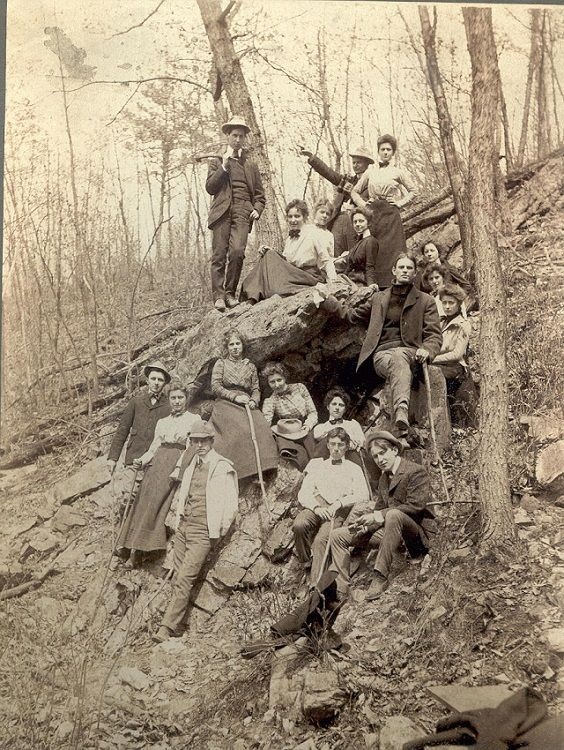
David Lewis' cave in Doubling Gap, surrounded by young adventurers, around the turn of the 20th century. (Courtesy of Cumberland County Historical Society, Carlisle, Pa.)

David Lewis' cave in Doubling Gap, surrounded by young adventurers, around the turn of the 20th century. (Courtesy of Cumberland County Historical Society, Carlisle, Pa.)
“There comes a time in every rightly-constructed boy’s life when he has a raging desire to go somewhere and dig for hidden treasure.”
– Mark Twain, The Adventures of Tom Sawyer
In 1820, the reign of Pennsylvania’s own Robin Hood, David Lewis, came to a violent end. His colorful persona made him larger than life, a legend in the valleys of the Allegheny.
Exploits of Lewis and his band of counterfeiting-highwaymen-thieves would be told for generations, as their daring escapes, ingenious plots, and brazen heists are the stuff of Hollywood. It is difficult to imagine a character such as this roaming our rolling hills; but what is harder still, is finding what is rumored to be out in those hills: treasure.
Lewis’ sensationalized life of crime began following his escape from prison at Fort Niagara in 1812. Traveling south, Lewis was pulled into the world of counterfeiting in New York and Vermont and would later carry the nefarious trade into central Pennsylvania. Forming his gang near Pine Grove, Pa., the legend of Lewis’ exploits flourished.
On one occasion cementing Lewis’ Robin Hood persona, Lewis went to rob an easy target: a lonely house along the main route from Philadelphia to Pittsburgh. When the door opened, a poor, elderly woman appeared. She explained to the highwaymen she had no money, and in fact, owed $50 to a local collector. Lewis apologized to the woman for the excitement, handed her $50 for the collector, then bid her farewell. As he rode out of sight, Lewis set up an ambush, and after the woman paid the collector, Lewis and company robbed him as he headed back toward town!
The business of counterfeiting and highway robbery were quite lucrative, and Lewis’ reputation soared. Locals secretly supported the “Robin Hood of Pennsylvania,” while the media labeled him the “Terror of the Cumberland Valley.” This notoriety would see Lewis become one of Pennsylvania’s most wanted.
Lost to history
Following stints in prison for counterfeiting and robbery, Lewis began notably utilizing caves to stage attacks and store loot. From caves throughout Centre, Huntington, Bedford, and Mifflin in 1819 and 1820, Lewis continued to lead successful robberies of wealthy merchants in Bellefonte, Bedford, and Carlisle. One noteworthy heist was the robbery of John McClelland. This risky venture saw Lewis and company rob the Pittsburgh merchant of $35,000 in modern value.
Lewis’ final assault on the Bellefonte merchant wagons of Hammond and Page would have been legendary had it all gone to plan, although mistakes proved to be fatal. As Lewis and his crew were killed or captured, their hideouts, their network of accomplices, and their hidden loot, would become lost to history.
With such historical provenance and confirmation, treasure hunting immediately captured the attention of central Pennsylvanians. On his prison deathbed several days after being grievously wounded in the shootout following the Hammond and Page heist, Lewis wrote a now-infamous letter to a farmer in the Spruce Creek Valley, detailing a stash worth $2.5 million today hidden in a dank hideout room from which he could see workmen working an old woolen mill, which some have triangulated to the old tourist “Indian Caverns.” Hoping to find some remnants of the Lewis haul, amateur sleuths began trying to decipher any correspondence of Lewis to his gang or hotel owners, and even prison and arrest records.
Since the days of David Lewis, treasure has been found that has been attributed to the Lewis gang. In the Altoona Tribune in 1934, it was reported that a mountaineer from Clear Creek brought a rusty pot of gold pieces into town and another “greybeard” from Sand Hollow brought a beaver hat full of gold and silver to a bank to be exchanged for cash. Another, in 1897, reportedly found a purse of gold containing $200 while digging stumps near the Centre County line.
Although remnants of this forgotten desperado surface on occasion, no one has yet been able to locate the main stash of David Lewis. Local lore tells of treasure hunters spending years visiting caves, metal detecting, and tracing the footsteps of the Lewis gang, with nothing more than a story to show for it.
Today, the treasure remains lost, with the last reported finding of any loot related to Lewis coming in the 1930s. However, with advancements in ground-penetrating imaging technology, drone surveys, and computing power, maybe all that’s missing, as Twain said, is the raging desire to go somewhere and dig for hidden treasure.
Sources:
“Concerted Efforts to Find David Lewis’ Treasure.” Altoona Tribune, 9 Mar. 1939, p. 6.
Lewis, David, and C. D. Rishel. The Life and Adventures of David Lewis: The Robber and Counterfeiter: The Terror of the Cumberland Valley. Newville Historical Society, 1991.
“Robber Lewis Recalled.” The Sentinel, 14 Aug. 1897, p. 3.
Local Historia is a passion for local history, community, and preservation. Its mission is to connect you with local history through engaging content and walking tours. Local Historia is owned by public historians Matt Maris and Dustin Elder, who co-author this column. For more, visit localhistoria.com.
Receive all the latest news and events right to your inbox.
403 S. Allen Street
State College, PA 16801
Phone: 814-238-5051
